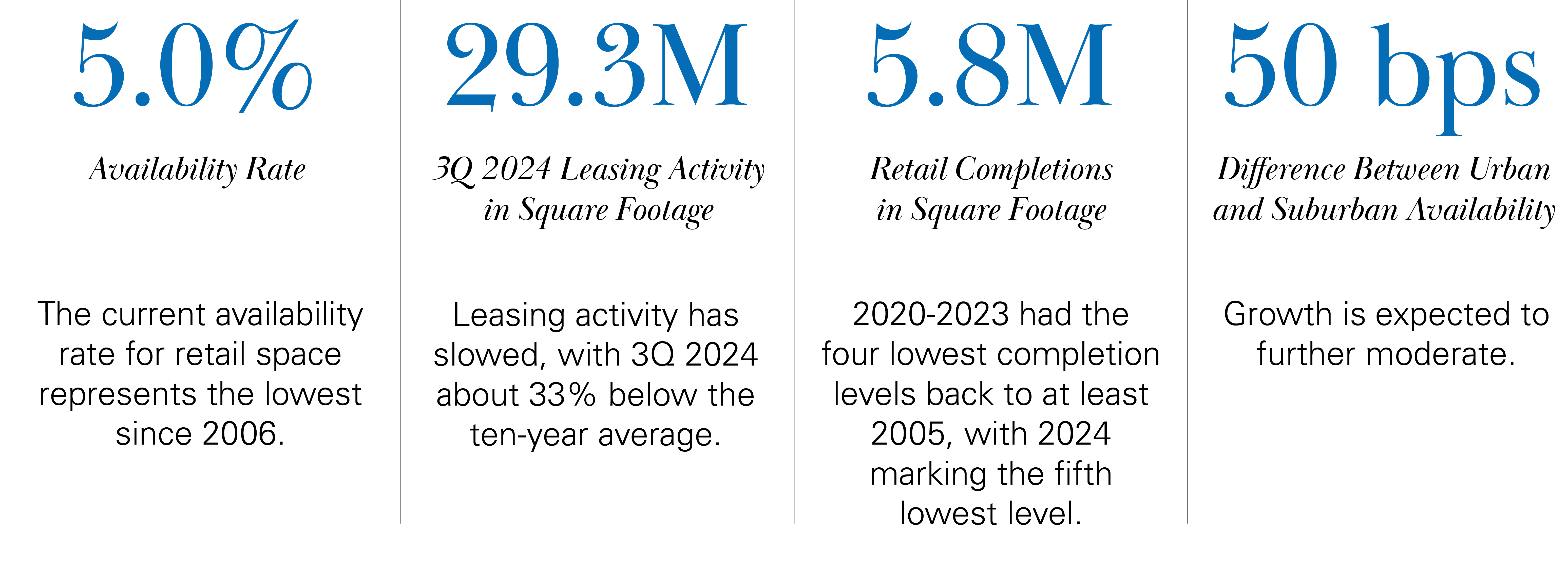Subscribe and receive Newmark Retail Thought Leadership updates.
- Insights>
- Market Reports>
- 3Q24 U.S. Retail Market: Conditions & Trends
3Q24 U.S. Retail Market: Conditions & Trends
November 13, 2024
Newmark presents the third quarter 2024 U.S. Retail Market: Conditions & Trends report.


You will now start receiving Newmark Retail thought Leadership updates.
In the third quarter of 2024, retail fundamentals remained at strong levels, with record-low availability and continued rent growth. Despite slower leasing activity overall, prime retail markets and trade areas continue to be in high demand. The lack of new retail projects under construction—and within the overall development pipeline—ensures current assets experience limited risk from new competition entering the market. As a result of a 10% cumulative return since December 2021, retail REITs are the only primary CRE type with a positive performance during that challenging period.
Economic Conditions and Demand Drivers

- Consumer wage growth is now outpacing inflation. Average hourly earnings have risen 3.9% year-over-year, yet challenges persist.
- Although wage growth has surpassed CPI for several quarters, consumer confidence in the current economic landscape remains subdued. Interestingly, their outlook for the future carries an 11-point premium—marking the highest level since 1980.
Leasing Market Fundamentals

- The U.S. retail availability rate holds steady at a decades-low 5.0%, despite a slowdown in leasing activity. Approximately 29.3 million SF of retail space was leased in the third quarter of 2024—around 33% below the ten-year average—largely due to limited availability in high-demand trade areas, particularly for prime retail assets.
- The trend favoring suburban over urban retail persists, with a 50-basis-point spread in demand between the two.
- With only 5.8 million SF of new retail space delivered this quarter, market conditions remain tight.
Capital Markets

- Retail capital markets in the U.S. remain subdued, with just 33.0 million SF traded in the third quarter of 2024. Price per SF is stable; however, the spread between high-quality and lower-quality retail properties continues to widen as many sites are acquired as value-add or opportunistic investments.
- Cap rates increased by 10 basis points sequentially and 50 basis points year-over-year, maintaining a solid spread over BBB Corporate Bonds, though not yet reaching late 2021 and early 2022 levels.
- Overall, fundamentals remain strong. A substantial influx of prime centers hitting the market in 2025 is expected to drive investment activity.


















